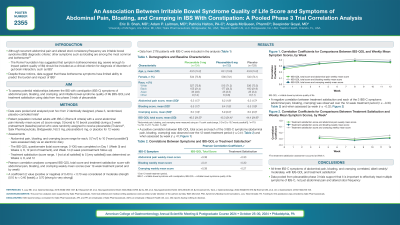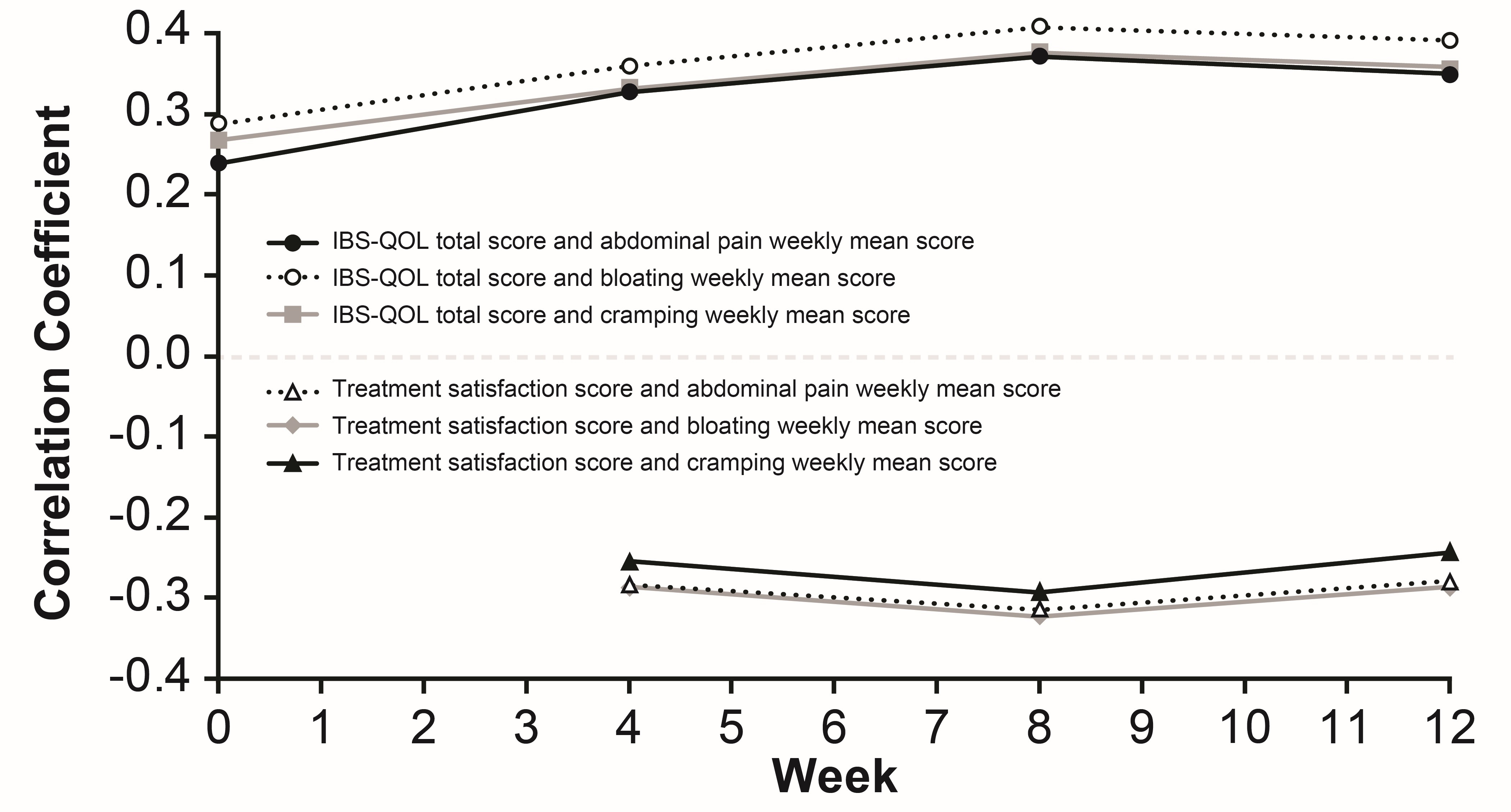Monday Poster Session
Category: Functional Bowel Disease
P2355 - An Association Between IBS Quality of Life Score and Symptoms of Abdominal Pain, Bloating, and Cramping in IBS-C: A Pooled Phase 3 Trial Correlation Analysis
Monday, October 28, 2024
10:30 AM - 4:00 PM ET
Location: Exhibit Hall E

Has Audio
- ES
Eric Shah, MD, MBA, FACG
University of Michigan
Ann Arbor, MI
Presenting Author(s)
Eric Shah, MD, MBA, FACG1, Adam P.. Laitman, MD2, Patricia Halton, PA-C2, Angela McQueen, PharmD3, Deepinder Goyal, MD4
1University of Michigan, Ann Arbor, MI; 2Salix Pharmaceuticals, Bridgewater, NJ; 3Bausch Health US, LLC, Bridgewater, NJ; 4Gastro Health, Orlando, FL
Introduction: Although recurrent abdominal pain and altered stool consistency/frequency are IBS diagnostic criteria, other symptoms such as bloating are among the most common and bothersome. Despite this notion, data suggest that these bothersome symptoms have limited ability to predict the burden and impact of IBS. The aim of this study was to assess potential relationships between the IBS-C symptoms of abdominal pain, bloating, and cramping, and IBS-QOL and treatment satisfaction.
Methods: Data were analyzed post hoc from 2 identically designed, phase 3, randomized trials. Adults with IBS-C (Rome III criteria) with a worst abdominal pain intensity mean score ≥ 3 (score range, 0 [none] to 10 [worst possible]) during a 2-week pretreatment (baseline) period, received plecanatide 3 mg, 6 mg, or placebo for 12 weeks. Abdominal pain, bloating, and cramping (score range for each, 0 [none] to 10 [worst possible]) were assessed daily via an electronic diary. The IBS-QOL questionnaire was completed on Day 1 (Week 0) and Weeks 4, 8, 12 (end of treatment), and 14. Treatment satisfaction (score range, 1 [not at all satisfied] to 5 [very satisfied]) was determined on Weeks 4, 8, and 12. Pearson correlation analyses compared IBS-QOL total score and treatment satisfaction score with abdominal pain, bloating, and cramping weekly mean scores (over 12-week treatment period and by week). A coefficient (r) value (positive or negative) of 0.40 to < 0.70 was considered of moderate strength (0.10 to < 0.40 [weak]; ≥ 0.70 [strong to very strong]).
Results: Data from 2176 patients were included. A positive correlation between IBS-QOL total score and each of the 3 IBS-C symptoms (abdominal pain, bloating, cramping) was observed over the 12-week treatment period (r ≤ 0.41; Table) and by week (r ≤ 41; Figure). In addition, a correlation between treatment satisfaction and each of the 3 IBS-C symptoms (abdominal pain, bloating, cramping) was observed over the 12-week treatment period (r ≤ –0.30; Table) and by week (r ≤ –0.32; Figure).
Discussion: IBS-C symptoms of abdominal pain, bloating, and cramping similarly correlated with IBS-QOL and treatment satisfaction. It is important to effectively treat multiple symptoms of IBS-C, not just abdominal pain and altered stool frequency.

Note: The table for this abstract can be viewed in the ePoster Gallery section of the ACG 2024 ePoster Site or in The American Journal of Gastroenterology's abstract supplement issue, both of which will be available starting October 27, 2024.
Disclosures:
Eric Shah, MD, MBA, FACG1, Adam P.. Laitman, MD2, Patricia Halton, PA-C2, Angela McQueen, PharmD3, Deepinder Goyal, MD4. P2355 - An Association Between IBS Quality of Life Score and Symptoms of Abdominal Pain, Bloating, and Cramping in IBS-C: A Pooled Phase 3 Trial Correlation Analysis, ACG 2024 Annual Scientific Meeting Abstracts. Philadelphia, PA: American College of Gastroenterology.
1University of Michigan, Ann Arbor, MI; 2Salix Pharmaceuticals, Bridgewater, NJ; 3Bausch Health US, LLC, Bridgewater, NJ; 4Gastro Health, Orlando, FL
Introduction: Although recurrent abdominal pain and altered stool consistency/frequency are IBS diagnostic criteria, other symptoms such as bloating are among the most common and bothersome. Despite this notion, data suggest that these bothersome symptoms have limited ability to predict the burden and impact of IBS. The aim of this study was to assess potential relationships between the IBS-C symptoms of abdominal pain, bloating, and cramping, and IBS-QOL and treatment satisfaction.
Methods: Data were analyzed post hoc from 2 identically designed, phase 3, randomized trials. Adults with IBS-C (Rome III criteria) with a worst abdominal pain intensity mean score ≥ 3 (score range, 0 [none] to 10 [worst possible]) during a 2-week pretreatment (baseline) period, received plecanatide 3 mg, 6 mg, or placebo for 12 weeks. Abdominal pain, bloating, and cramping (score range for each, 0 [none] to 10 [worst possible]) were assessed daily via an electronic diary. The IBS-QOL questionnaire was completed on Day 1 (Week 0) and Weeks 4, 8, 12 (end of treatment), and 14. Treatment satisfaction (score range, 1 [not at all satisfied] to 5 [very satisfied]) was determined on Weeks 4, 8, and 12. Pearson correlation analyses compared IBS-QOL total score and treatment satisfaction score with abdominal pain, bloating, and cramping weekly mean scores (over 12-week treatment period and by week). A coefficient (r) value (positive or negative) of 0.40 to < 0.70 was considered of moderate strength (0.10 to < 0.40 [weak]; ≥ 0.70 [strong to very strong]).
Results: Data from 2176 patients were included. A positive correlation between IBS-QOL total score and each of the 3 IBS-C symptoms (abdominal pain, bloating, cramping) was observed over the 12-week treatment period (r ≤ 0.41; Table) and by week (r ≤ 41; Figure). In addition, a correlation between treatment satisfaction and each of the 3 IBS-C symptoms (abdominal pain, bloating, cramping) was observed over the 12-week treatment period (r ≤ –0.30; Table) and by week (r ≤ –0.32; Figure).
Discussion: IBS-C symptoms of abdominal pain, bloating, and cramping similarly correlated with IBS-QOL and treatment satisfaction. It is important to effectively treat multiple symptoms of IBS-C, not just abdominal pain and altered stool frequency.

Figure: Figure. Correlation Coefficients for Comparisons, by Week*
*First treatment satisfaction assessment occurred at Week 4.
*First treatment satisfaction assessment occurred at Week 4.
Note: The table for this abstract can be viewed in the ePoster Gallery section of the ACG 2024 ePoster Site or in The American Journal of Gastroenterology's abstract supplement issue, both of which will be available starting October 27, 2024.
Disclosures:
Eric Shah: Ardelyx – Consultant. Ironwood Pharmaceuticals – Consultant. Mahana Therapeutics – Consultant. Mylan – Consultant. Phathom – Consultant. Salix Pharmaceuticals – Consultant. Sanofi – Consultant. Takeda – Consultant.
Adam Laitman: Salix Pharmaceuticals – Employee.
Patricia Halton: Salix Pharmaceuticals – Employee.
Angela McQueen: Bausch Health US, LLC – Employee.
Deepinder Goyal indicated no relevant financial relationships.
Eric Shah, MD, MBA, FACG1, Adam P.. Laitman, MD2, Patricia Halton, PA-C2, Angela McQueen, PharmD3, Deepinder Goyal, MD4. P2355 - An Association Between IBS Quality of Life Score and Symptoms of Abdominal Pain, Bloating, and Cramping in IBS-C: A Pooled Phase 3 Trial Correlation Analysis, ACG 2024 Annual Scientific Meeting Abstracts. Philadelphia, PA: American College of Gastroenterology.
